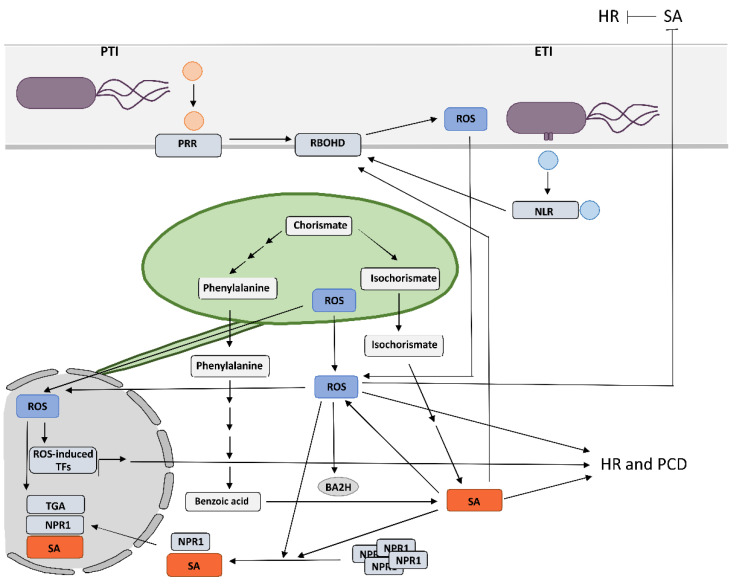Figure 1.
Intertwined roles of reactive oxygen species and salicylic acid signaling in plant response to biotic stress. The scheme represents the crosstalk between salicylic acid (SA) and reactive oxygen species (ROS) signaling. Pathogen-associated molecular-pattern-triggered immunity (PTI) is mediated by cell-surface-localized pattern recognition receptors (PRRs), which recognize conserved microbial- or pathogen-associated molecular patterns (MAPMs or PAMPs) extracellularly. Intracellular-nucleotide-binding domain leucine-rich repeat receptors (NLRs) detect pathogen effector proteins within cells and activate effector-triggered immunity (ETI). Successful ETI often results in hypersensitive response (HR)-conferred resistance and programmed cell death (PCD). The role of RBOHD has been shown in both PTI and ETI. For simplicity, bacterial pathogen induces NLR on the scheme; however, the role of RBOH-generated ROS in HR cell death and/or HR-conferred resistance has also been confirmed for viral, oomycete, and fungal pathosystems. Superoxide produced by NADPH oxidases (RBOH) is spontaneously or by superoxide dis-mutase (SOD) converted to hydrogen peroxide (H2O2), which crosses plasmalemma via free diffusion or aquaporin-facilitated diffusion to enter the cell. SA is known as a chief regulator of ROS production by regulating RBOH transcription. Plants possess isochorismate synthase and phenylalanine ammonia-lyase pathways to synthesize SA, both starting from chorismate precursor. Benzoic acid is converted into SA by BA2H, which is regulated by ROS. Higher SA level and change of redox state induce monomerization of NPR1, translocation into the nucleus, and NPR1-dependent gene expression through direct interactions with TGA transcription factors. Intercellular ROS inhibits SA accumulation and HR in the adjacent cells. Chloroplastic ROS might, in addition to signaling in HR cell death, also be involved in controlling plant immune responses by reprogramming transcription of genes involved in response to pathogen attack as one of the retrograde signals either directly via stromules or by first entering the cytosol. In the nucleus, control of gene expression depends mainly on the activity of TFs that interact with oxidative-stress-responsive cis-regulatory elements within the gene promoters. The intertwined roles of ROS and SA in immunity are pathosystem- and RBOH-isoform-dependent; however, note that the scheme is simplified. SA: salicylic acid, ROS: reactive oxygen species, RBOHD: respiratory burst oxidase homolog (RBOH) NADPH oxidases D, BA2H: benzoic acid 2-hydroxylase, NPR1: nonexpresser of PR gene 1, TFs: transcription factors.

